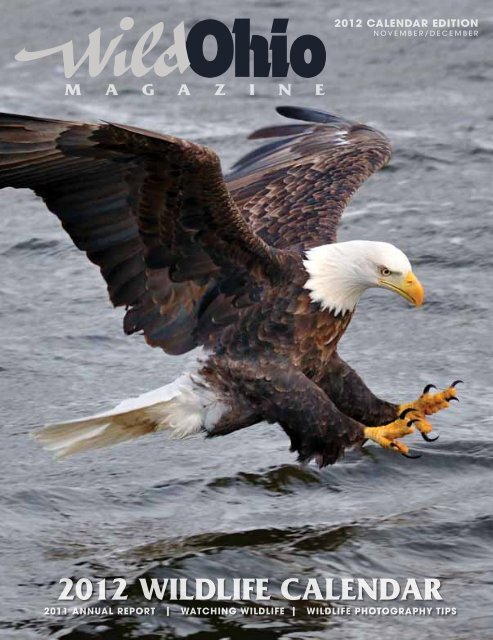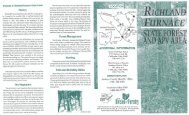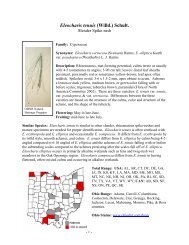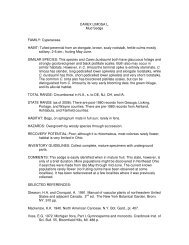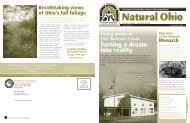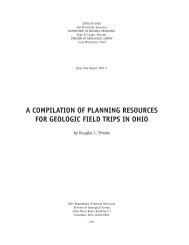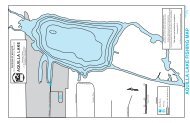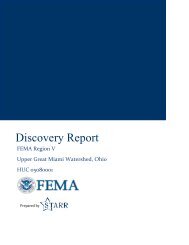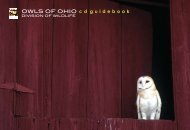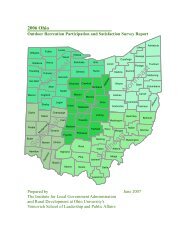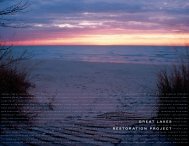2012 WILDLIFE CALENDAR - Ohio Department of Natural Resources
2012 WILDLIFE CALENDAR - Ohio Department of Natural Resources
2012 WILDLIFE CALENDAR - Ohio Department of Natural Resources
Create successful ePaper yourself
Turn your PDF publications into a flip-book with our unique Google optimized e-Paper software.
<strong>2012</strong> calendar edition<br />
N O V E M B E R / D E C E M B E R<br />
<strong>2012</strong> <strong>WILDLIFE</strong> <strong>CALENDAR</strong><br />
2011 annual report i Watching Wildlife i Wildlife photography tips
One <strong>of</strong> the goals <strong>of</strong> the enhanced Wild <strong>Ohio</strong> Magazine is to<br />
provide all outdoor enthusiasts a magazine that is more ...<br />
... more information, more wildlife, and more <strong>Ohio</strong>.<br />
WHEEL BUG<br />
As you turn the pages <strong>of</strong> this issue <strong>of</strong> Wild <strong>Ohio</strong>, we<br />
want to bring to your attention an important theme –<br />
<strong>Ohio</strong>. Our featured photographers are <strong>Ohio</strong>ans, taking<br />
pictures in <strong>Ohio</strong>, <strong>of</strong> <strong>Ohio</strong>’s wildlife. Many <strong>of</strong> the<br />
photos were uploaded onto our online photo gallery,<br />
where pr<strong>of</strong>essional and aspiring wildlife photographers<br />
have shared their point <strong>of</strong> view with everyone<br />
who views the gallery at wildohio.com. The photo gallery<br />
is one <strong>of</strong> the most popular places on the website,<br />
especially during the annual deer-gun season. Photos<br />
submitted to the photo gallery have been published<br />
in brochures, regulations, and the pages <strong>of</strong> your Wild<br />
<strong>Ohio</strong> magazine. Interested in sharing <strong>Ohio</strong>’s wildlife<br />
from your perspective? Visit wildohio.com and<br />
upload your photos, or send your shots and contact<br />
information to wildohiomagazine@dnr.state.oh.us<br />
W I L D O H I O M A G A Z I N E<br />
hey photographers!<br />
INTERESTED IN SHARING OHIO’S <strong>WILDLIFE</strong> FROM YOUR PERSPECTIVE?<br />
O H I O P H O T O G R A P H E R JOSEPH KERNS<br />
Joseph Kerns enjoys wildlife while hunting, fishing,<br />
birding, and behind the lens <strong>of</strong> a camera. Kerns’ favorite<br />
subject to photograph is raptors – particularly<br />
eagles. Photography is a hobby for Kerns, and he suggests<br />
that those interested in photography should approach<br />
wildlife the same manner a successful hunter<br />
does – with steady patience.<br />
MANY PEOPLE BENEFIT FROM <strong>WILDLIFE</strong>’S WEBSITE AND PHOTO GALLERY!<br />
“I visit the Division <strong>of</strong> Wildlife’s website to see updates to regulations, watch the falcon cam,<br />
check the photo gallery, and just to feel in touch with home. Traveling to other states, I can say<br />
that <strong>Ohio</strong>’s site is one <strong>of</strong> the best. I look forward to coming home every deer season that I am<br />
not forward deployed.”<br />
R. Robbins, U.S. Navy<br />
DIVISION OF <strong>WILDLIFE</strong><br />
HEADQUAR TERS<br />
2045 Morse Road, Bldg. G<br />
Columbus, OH 43229-6693<br />
(614) 265-6300 (Voice)<br />
1-800-<strong>WILDLIFE</strong><br />
1-800-750-0750<br />
(<strong>Ohio</strong> Relay TTY only)<br />
<strong>WILDLIFE</strong> DISTRICT ONE<br />
1500 Dublin Road<br />
Columbus, OH 43215<br />
(614) 644-3925<br />
<strong>WILDLIFE</strong> DISTRICT TWO<br />
952 Lima Avenue<br />
Findlay, OH 45840<br />
(419) 424-5000<br />
<strong>WILDLIFE</strong> DISTRICT THREE<br />
912 Portage Lakes Drive<br />
Akron, OH 44319<br />
(330) 644-2293<br />
<strong>WILDLIFE</strong> DISTRICT FOUR<br />
360 E. State Street<br />
Athens, OH 45701<br />
(740) 589-9930<br />
<strong>WILDLIFE</strong> DISTRICT FIVE<br />
1076 Old Springfield Pike<br />
Xenia, OH 45385<br />
(937) 372-9261<br />
WILD OHIO IS PROVIDED FREE OF CHARGE COURTESY OF<br />
OHIO ANGLERS', HUNTERS', AND TRAPPERS' ANNUAL LICENSE FEES.<br />
• NO STATE TAX DOLLARS ARE USED FOR THIS PUBLICATION •<br />
PROTHONOTARY WARBLER<br />
Al Freeman<br />
I N T H E N E X T I S S U E<br />
W H A T T O L O O K F O R W A R D T O I N T H E N E X T I S S U E O F<br />
Wild <strong>Ohio</strong> Magazine<br />
• Birding Apps for Your Smartphone • Young Birders’ Club<br />
• <strong>Ohio</strong>’s Warblers • <strong>Ohio</strong> River Sauger • How to Ice Fish<br />
• Deer: Cooking Beyond the Ground . . . and Much More!<br />
Visit wildohio.com to sign-up for your magazine!<br />
D I V I S I O N O F W I L D L I F E<br />
The mission <strong>of</strong> the Division <strong>of</strong> Wildlife is to conserve and improve fish and wildlife<br />
resources and their habitats for sustainable use and appreciation by all.<br />
for general information<br />
1-800-<strong>WILDLIFE</strong><br />
( 9 4 5 - 3 5 4 3 )<br />
for Lake Erie fishing report<br />
1-888-HOOKFISH<br />
( 4 6 6 - 5 3 4 7 )<br />
to report poaching<br />
1-800-POACHER<br />
( 7 2 6 - 2 4 3 7 )<br />
wildohio.com<br />
E-MAIL<br />
wildohiomagazine@<br />
dnr.state.oh.us<br />
FACEBOOK<br />
facebook.com/<br />
ohiodivision<strong>of</strong>wildlife<br />
TWITTER<br />
twitter.com/<strong>Ohio</strong>DivWildlife
WOOD DUCK<br />
Al Freeman<br />
MAGAZINE STAFF<br />
E D I T O R I A L<br />
Vicki Mountz<br />
executive editor<br />
Susie Vance<br />
managing editor<br />
Lisa Smith<br />
technical editor<br />
Vicki Ervin<br />
associate editor<br />
V I S U A L<br />
Chuck Greenwalt<br />
production manager<br />
Tim Daniel<br />
photographer<br />
Chad Crouch<br />
senior designer<br />
D E PA R T M E N T L I A I S O N S<br />
Scott Hale<br />
fish management<br />
Kathy Shipley<br />
wildlife management<br />
Kendra Wecker<br />
wildlife diversity<br />
OHIO DEPARTMENT OF<br />
NATURAL RESOURCES<br />
John R. Kasich<br />
governor, state <strong>of</strong> ohio<br />
Scott Zody<br />
INTERIM director, o.d.n.r<br />
David B. Lane<br />
chief, division <strong>of</strong> wildlife<br />
WILD OHIO (ISSN 1061-1541) is published<br />
six times a year by the <strong>Ohio</strong> <strong>Department</strong><br />
<strong>of</strong> <strong>Natural</strong> <strong>Resources</strong>, Division <strong>of</strong> Wildlife,<br />
2045 Morse Road, Bldg. G, Columbus, OH<br />
43229-6693.<br />
To sign-up online, visit wildoiho.com.<br />
Periodicals postage paid at Columbus,<br />
<strong>Ohio</strong> and additional mailing <strong>of</strong>fices.<br />
POSTMASTER: Send address changes to:<br />
ODNR Division <strong>of</strong> Wildlife<br />
2045 Morse Road, Bldg. G<br />
Columbus OH 43229-6693<br />
Total Circulation: 87,000<br />
Requested Circulation: 56,280<br />
Free Distribution: 30,720<br />
EQUAL OPPORTUNITY • The Division<br />
<strong>of</strong> Wildlife <strong>of</strong>fers equal opportunity<br />
regardless <strong>of</strong> race, color, national origin,<br />
age, disability or sex. If you believe you<br />
have been discriminated against in any<br />
program, activity, or facility, you should<br />
contact:.<br />
The U. S. Fish and Wildlife Service<br />
Office for Diversity and Civil Rights<br />
Programs-External Programs<br />
4040 N. Fairfax Drive, Suite 130<br />
Arlington, VA 22203<br />
<strong>Ohio</strong> <strong>Department</strong> <strong>of</strong> <strong>Natural</strong> <strong>Resources</strong><br />
Diversity Affairs Office<br />
2045 Morse Road, Bldg. D-1<br />
Columbus, OH 43229<br />
M A G A Z I N E<br />
C O V E R F E A T U R E<br />
D E P A R T M E N T S<br />
T A B L E O F C O N T E N T S<br />
6<br />
9<br />
13<br />
17<br />
21<br />
25<br />
29<br />
ON THE Cover: BALD EAGLE<br />
Our national symbol, the bald eagle, displays many outstanding characteristics -<br />
exceptional vision, a striking appearance, and a commanding presence.<br />
Photo by Richard Cleis • www.richardcleis.com<br />
4 WILD THINGS • NEWS FROM AROUND OHIO<br />
5 LAW ENFORCEMENT • FIELD NOTES<br />
32 WATCHABLE <strong>WILDLIFE</strong> • WATCHING <strong>WILDLIFE</strong> ALL YEAR <br />
33 OUTDOOR SKILLS • MAKE YOUR HOME A <strong>WILDLIFE</strong> STUDIO<br />
34 READER’S PHOTOS • IMAGES FROM AROUND OHIO<br />
35 WILD GAME GOURMET • TURKEY & VENISON<br />
V O L U M E 2 2 , N U M B E R 4<br />
ANNUAL REPORT<br />
A letter from the Chief <strong>of</strong> the Division <strong>of</strong> Wildlife<br />
recaps the 2011 highlights and future prospects.<br />
C A L E N D A R F E A T U R E S<br />
JANUARY: NORTHERN CARDINAL<br />
The male cardinal is an unmistakable brilliant red<br />
with black facial markings and a crested head.<br />
MARCH: BROWN TROUT<br />
Introduced before the turn <strong>of</strong> the century, brown<br />
trout have become a popular sport fish in <strong>Ohio</strong>.<br />
MAY: LONGTAIL SALAMANDER<br />
The tail accounts for more than half the total<br />
length <strong>of</strong> the mature adult.<br />
JULY: RUBY-THROATED HUMMINGBIRD<br />
The rubythroat is among the smallest <strong>of</strong> birds,<br />
weighing less than an ounce.<br />
SEPTEMBER: MOURNING DOVE<br />
Mourning doves rank among the most familiar<br />
breeding birds in <strong>Ohio</strong>.<br />
NOVEMBER: WHITE-TAILED DEER<br />
Whitetails are active around the clock, but most<br />
<strong>of</strong>ten, they are on the move at dawn and dusk.<br />
Total Printed: 87,000 Unit Cost: 0.XXX Pub. Date: XX/XX<br />
GRAY FOX
WILD THINGS<br />
Division ANNOUNCES<br />
NEW LEADERSHIP<br />
Sue Howard and Tom Rowan will serve<br />
in the respective positions <strong>of</strong> assistant chief<br />
<strong>of</strong> operations and assistant chief <strong>of</strong> programs<br />
for the <strong>Ohio</strong> Division <strong>of</strong> Wildlife.<br />
As assistant chief <strong>of</strong> operations, Howard<br />
will oversee administration <strong>of</strong> the division’s<br />
five statewide wildlife districts as<br />
well as business operations at its central<br />
<strong>of</strong>fice in Columbus.<br />
LAKE ERIE WATERSNAKE<br />
BENNY MAZUR<br />
Lake Erie Watersnake Removed from<br />
Federal Endangered Species List<br />
The Lake Erie watersnake, a<br />
federally<br />
threatened and state endangered species,<br />
has been removed from the federal government’s<br />
list <strong>of</strong> threatened species under the<br />
Endangered Species Act. This reptile has<br />
one <strong>of</strong> the smallest geographic distributions<br />
<strong>of</strong> any North American vertebrate and is<br />
found almost exclusively on the Lake Erie<br />
Islands.<br />
Listed as a federally threatened species in<br />
1999, The Lake Erie watersnake was elevated<br />
to state endangered status in 2000. At<br />
2011 marks another year <strong>of</strong> increased<br />
numbers <strong>of</strong> young peregrine falcons and<br />
eagles fledging across <strong>Ohio</strong>.<br />
Peregrines i There were 39 sites with territorial<br />
pairs <strong>of</strong> peregrines, <strong>of</strong> which 34 nests<br />
produced eggs. Of those nests, 26 hatched<br />
young falcons and 24 sites fledged 67 juveniles<br />
successfully. Additionally, there were<br />
two new sites with territorial pairs in <strong>Ohio</strong>.<br />
that time, three primary issues threatened<br />
the continued survival <strong>of</strong> this non-venomous<br />
species: small population size, habitat<br />
destruction, and direct mortality from people.<br />
Since then, the division, with the help<br />
<strong>of</strong> federal and private partners, has worked<br />
to secure habitat as well as inform and educate<br />
the public about this unique species.<br />
A land management plan was established<br />
on all state-owned island properties to ensure<br />
enough suitable habitat is available for<br />
long-term conservation.<br />
2011 Nesting Season a Success<br />
Eagles i 194 nesting pairs <strong>of</strong> bald eagles<br />
hatched 254 young in 2011. There were 35<br />
confirmed new nests this year. Bald eagles<br />
have now been confirmed in 62 counties.<br />
BALD EAGLE<br />
AL FREEMAN<br />
In his new position as assistant chief <strong>of</strong><br />
programs, Rowan will supervise the division’s<br />
four main program areas: Wildlife<br />
Law Enforcement, Fish Management,<br />
Wildlife Management, and Information &<br />
Education.<br />
left to right: Jody Chamberlain, Williams SWCD<br />
(nominator), Bill Grimes, Defiance SWCD (award<br />
recipient), Jen Dennison, <strong>Ohio</strong> Project WILD<br />
Coordinator, Division <strong>of</strong> Wildlife.<br />
Environmental<br />
Education Award<br />
The Division <strong>of</strong> Wildlife and the Council<br />
for Environmental Education (CEE)<br />
have awarded Bill Grimes, education<br />
specialist for the Defiance Soil and Water<br />
Conservation District (SWCD), with<br />
their “<strong>Ohio</strong> Project WILD Facilitator <strong>of</strong><br />
the Year Award.” This annual award is given<br />
to a volunteer Project WILD facilitator<br />
who the division and CEE believe has<br />
contributed significantly to <strong>Ohio</strong>’s Project<br />
WILD program.<br />
4 W I L D O H I O M A G A Z I N E
<strong>WILDLIFE</strong> LAW ENFORCEMENT<br />
FIELD NOTES<br />
Outfitter<br />
Pleads Guilty<br />
A Logan County resident recently plead<br />
guilty to three state wildlife violations and<br />
one charge <strong>of</strong> falsification in the Bellefontaine<br />
Municipal Court.<br />
Butler County Fishermen Pay<br />
High Price for Undersize Crappie<br />
Two Butler County residents were ordered<br />
to pay a total <strong>of</strong> $450 in fines and<br />
$3,400 in restitution after being convicted<br />
<strong>of</strong> possessing undersized fish. Wildlife Officer<br />
Brad Turner was performing routine<br />
fishing license and fish bag and length limit<br />
checks at Acton Lake on Memorial Day<br />
weekend. When Officer Turner checked the<br />
anglers’ boat, he found that they had 177<br />
crappie in their possession. After inspecting<br />
the fish, Officer Turner determined that<br />
170 <strong>of</strong> the fish were less than nine inches<br />
in length. Acton Lake, located at Hueston<br />
Woods State Park in Preble County, has<br />
a nine-inch length limit on crappie. Both<br />
men were charged with possessing undersize<br />
fish. A daily bag limit <strong>of</strong> 30 crappies is<br />
in effect on a total <strong>of</strong> 44 <strong>Ohio</strong> lakes with a<br />
nine-inch size limit. The goal <strong>of</strong> these regulations<br />
is to improve the quality <strong>of</strong> crappie<br />
fishing by increasing the numbers <strong>of</strong> larger<br />
fish available for crappie anglers to catch.<br />
The man was sentenced to serve 60 days<br />
in jail (55 days suspended), two years <strong>of</strong><br />
probation, and pay a $1,000 fine. The conviction<br />
stems from false claims <strong>of</strong> wrongdoing<br />
made against a state wildlife <strong>of</strong>ficer<br />
in May 2010. Conditions <strong>of</strong> the probation<br />
stipulate no possession <strong>of</strong> firearms and no<br />
criminal or wildlife convictions for two<br />
years.<br />
The individual was also convicted on<br />
one count <strong>of</strong> carrying a hunting implement<br />
while accompanying a youth during<br />
a youth season as well as two counts<br />
<strong>of</strong> failure to keep accurate written records<br />
as a deer propagator, which resulted in an<br />
additional $750.00 fine. The individual’s<br />
hunting license was suspended for two<br />
years. His name also will be entered into<br />
the Interstate Wildlife Violator’s Compact,<br />
which most likely will result in his loss <strong>of</strong><br />
hunting rights in 35 other states.<br />
<strong>WILDLIFE</strong> OFFICER AWARDED<br />
The Mississippi Flyway Council has<br />
named Wildlife Officer Scott Denamen as<br />
the 2010/11 <strong>Ohio</strong> Waterfowl Protection<br />
Officer <strong>of</strong> the Year. Over the<br />
years, Officer Denamen has continually<br />
demonstrated his dedication<br />
to waterfowl resources. Going<br />
beyond surveillance,<br />
investigation, and enforcement,<br />
Denamen extends<br />
his involvement to various<br />
waterfowl related activities. Denamen<br />
serves as a field training <strong>of</strong>ficer, where<br />
he teaches newly hired <strong>of</strong>ficers the<br />
proper strategies and procedures for<br />
waterfowl enforcement. He is active<br />
within the division’s enforcement,<br />
wildlife management,<br />
and education<br />
sections on waterfowl<br />
issues in <strong>Ohio</strong>. Denamen<br />
has been active<br />
in several projects, including banding<br />
Canada Geese for research, maintaining<br />
wood duck nesting structures, membership<br />
in the Ducks Unlimited Geauga County<br />
Committee, and several youth hunting initiatives,<br />
including Geauga County’s Ducks<br />
Unlimited Chapter’s annual Greenwing<br />
event. This award recognizes Officer Denamen<br />
for his dedication to the sportsmen<br />
and the wildlife resources <strong>of</strong> <strong>Ohio</strong>.<br />
2 0 1 2 C A L E N D A R E D I T I O N<br />
5
DIVISION OF <strong>WILDLIFE</strong> FISCAL YEAR 2011<br />
O H I O D E P A R T M E N T O F N A T U R A L R E S O U R C E S<br />
I would like to take this opportunity to thank our customers who have supported the<br />
<strong>Ohio</strong> Division <strong>of</strong> Wildlife over the last year. Thanks to your support and stewardship,<br />
<strong>Ohio</strong> <strong>of</strong>fers some <strong>of</strong> the best hunting, fishing, trapping, and wildlife viewing found in<br />
our great nation. Whether you are fishing Lake Erie, hunting turkeys in southern <strong>Ohio</strong>,<br />
or bird watching in central <strong>Ohio</strong>, our pr<strong>of</strong>essional staff is dedicated to bringing you a<br />
quality outdoor experience. Some <strong>of</strong> our success stories, such as the delisting <strong>of</strong> the<br />
Lake Erie water snake and the increased participation <strong>of</strong> our youth, can be contributed<br />
to the strength <strong>of</strong> our conservation partners and countless volunteers throughout the<br />
state. Although the future will hold many challenges, the Division <strong>of</strong> Wildlife will continue<br />
our dedication to conserve and improve fish and wildlife resources and their habitats<br />
for sustainable use and appreciation by all. I am confident that with your continued<br />
support we can pass our conservation legacy on to the next generation.<br />
OHIO <strong>WILDLIFE</strong> COUNCIL<br />
David B. Lane, Chief<br />
O H I O D I V I S I O N O F W I L D L I F E<br />
KIM<br />
DAVIS<br />
CHARLES<br />
FRANKS<br />
HORACE<br />
KARR<br />
LARRY<br />
MIXON, SR.<br />
TIMOTHY<br />
RATLIFF<br />
KAREN<br />
STEWART-LINKHART<br />
PAUL<br />
MECHLING, II<br />
JAMES<br />
LYNCH<br />
The <strong>Ohio</strong> Wildlife Council is an eight-member board that reviews all Division<br />
<strong>of</strong> Wildlife proposed rules and regulations. Appointed by the governor,<br />
no more than four members may be <strong>of</strong> the same political party and<br />
two <strong>of</strong> the council members must represent agriculture. Each member’s<br />
term is four years.<br />
6 W I L D O H I O M A G A Z I N E
FINANCIAL REPORT 07.01.10 - 06.30.11<br />
*(P-R Wildlife Restoration & D-J Sport Fish Restoration)<br />
22%<br />
FEDERAL AID*<br />
$12,230,028<br />
2011 REVENUE $56,299,062<br />
2011 EXPENDITURES $59,019,585<br />
19%<br />
HUNTING LICENSE<br />
$10,880,415<br />
25%<br />
FISHING LICENSE<br />
$14,042,662<br />
19%<br />
FISH MANAGEMENT<br />
$11,046,659<br />
17%<br />
DISTRICT & STATEWIDE<br />
OPERATIONS<br />
$9,792,665<br />
19%<br />
DEER PERMITS<br />
$10,510,009<br />
20%<br />
<strong>WILDLIFE</strong> MANAGEMENT<br />
$11,813,610<br />
13%<br />
CAPITAL<br />
$7,634,370<br />
$3,312,799 OTHER REVENUE 6%<br />
$2,208,731 MOTOR VEHICLE FUEL TAX 4%<br />
$1,465,267 TURKEY PERMITS 3%<br />
$933,829 <strong>WILDLIFE</strong> DIVERSITY & 2%<br />
ENDANGERED SPECIES FUND<br />
$341,136 WETLANDS HABITAT STAMP 1%<br />
$374,186 FINES 1%<br />
<strong>WILDLIFE</strong> MANAGEMENT<br />
$11,813,610<br />
Wildlife Management and Research<br />
is responsible for managing<br />
all wildlife, assisting<br />
landowners with habitat improvements,<br />
managing land for<br />
wildlife and wildlife-oriented<br />
recreation, monitoring wildlife<br />
populations and harvest, and<br />
conducting applied research to<br />
be used in improving wildlife<br />
populations, regulations, and<br />
public satisfaction with <strong>Ohio</strong>’s<br />
wildlife resources.<br />
CAPITOL IMPROVEMENTS<br />
$7,634,370<br />
These funds are spent on land<br />
purchases and the repair, maintenance,<br />
renovation, and construction<br />
<strong>of</strong> facilities such as<br />
fishing access sites, boat ramps,<br />
hatcheries, and <strong>of</strong>fices.<br />
LAW ENFORCEMENT<br />
$6,232,385<br />
<strong>WILDLIFE</strong> OFFICERS<br />
$7,260,690<br />
Enforcement is a fish and wildlife<br />
management tool designed<br />
to protect resources, ensure fair<br />
and equitable use, protect state<br />
property, and implement fish<br />
and wildlife, litter, and pollution<br />
statutes. Wildlife <strong>of</strong>ficers<br />
are assigned to each <strong>of</strong> <strong>Ohio</strong>’s 88<br />
counties and Lake Erie.<br />
DISTRICT AND STATEWIDE<br />
OPERATIONS<br />
$9,792,665<br />
Expenditures include money<br />
spent for fiscal and business<br />
management, licensing and<br />
permits, property management,<br />
computer services, environmental<br />
research and review, and wetlands<br />
habitat restoration.<br />
12%<br />
<strong>WILDLIFE</strong> OFFICERS<br />
$7,260,690<br />
11%<br />
LAW<br />
ENFORCEMENT<br />
$6,232,385<br />
7% INFORMATION & EDUCATION $4,142,585<br />
2% ADMINISTRATION $1,096,621<br />
EXPLANATION OF<br />
EXPENDITURES<br />
INFORMATION AND<br />
EDUCATION<br />
$4,142,585<br />
Monies spent include hunter,<br />
trapper, and angler education,<br />
printing <strong>of</strong> licenses and regulations,<br />
educational materials for<br />
<strong>Ohio</strong>’s educators, maintaining<br />
the division’s electronic newsletter,<br />
website, Wild <strong>Ohio</strong> television<br />
program and magazine,<br />
information distribution to the<br />
media and public, and the creation<br />
and printing <strong>of</strong> maps and<br />
other publications.<br />
ADMINISTRATION<br />
$1,096,621<br />
Expenditures in this category<br />
include money spent for wildlife<br />
administration and human resources<br />
staff as well as statewide<br />
costs associated with employee<br />
recruitment, safety, and training<br />
needs as well as employee<br />
wellness programs including<br />
required medical testing such as<br />
random drug testing, respirator<br />
medical clearance, lead testing,<br />
and preventative medical services<br />
such as rabies and Hepatitis<br />
B vaccinations.<br />
FISH MANAGEMENT<br />
$11,046,659<br />
Fish Management and Research maintains the aquatic resources <strong>of</strong><br />
the state. Biologists and other fisheries personnel manage water areas<br />
by improving spawning habitat and fishing access, recommending<br />
regulations, monitoring fish populations and angler harvest, fish<br />
stocking, and research.<br />
2 0 1 2 C A L E N D A R E D I T I O N<br />
7
O H I O P H O T O G R A P H E R JACK HOYING<br />
Photography is a hobby that Jack Hoying tries to practice on a daily basis with his “photo a day” project. A Fort<br />
Loramie resident and owner <strong>of</strong> a custom cabinet business, Jack’s favorite subjects are wildlife, landscape, and<br />
travel scenery as well as some studio and casual portrait photography.<br />
www.pbase.com/jmhoying<br />
NOR THERN CARDINAL<br />
OHIO DEPARTMENT OF NATURAL RESOURCES<br />
DIVISION OF <strong>WILDLIFE</strong>
JANUARY<br />
VISIT<br />
THE <strong>CALENDAR</strong> OF EVENTS AT WILDOHIO.COM FOR ACTIVITIES IN YOUR AREA<br />
1<br />
S U N D A Y M O N D A Y T U E S D A Y W E D N E S D A Y T H U R S D A Y F R I D A Y S A T U R D A Y<br />
2<br />
3<br />
4<br />
5<br />
6<br />
7<br />
NEW YEAR’S DAY<br />
8<br />
9 10 11 12 13 14<br />
15 16 17 18 19 20 21<br />
22<br />
MARTIN LUTHER KING DAY<br />
23<br />
24 25 26 27 28<br />
29<br />
CHINESE NEW YEAR<br />
30<br />
31<br />
D E C E M B E R 2011<br />
Su Mo Tu We Th Fr Sa<br />
– – – – – – –<br />
1 2 3<br />
4 5 6 7 8 9 10<br />
F E B R U A R Y<br />
Su Mo Tu We Th Fr Sa<br />
– – – – – – –<br />
1 2 3 4<br />
5 6 7 8 9 10 11<br />
11 12 13 14 15 16 17<br />
12 13 14 15 16 17 18<br />
18 19 20 21 22 23 24<br />
19 20 21 22 23 24 25<br />
25 26 27 28 29 30 31<br />
26 27 28 29<br />
NORTHERN CARDINAL<br />
The cardinal is the state bird <strong>of</strong> <strong>Ohio</strong>. The male cardinal is<br />
an unmistakable brilliant red with black facial markings and<br />
a crested head. Females also have a head crest, but overall<br />
are duller in coloration. Cardinals prefer a mixed habitat <strong>of</strong><br />
woodlands, brush, and forest edges. They eat a variety <strong>of</strong><br />
seeds that their thick, cone-shaped beak is well adapted<br />
to handling. Cardinals do not migrate, but individuals may<br />
wander over a widespread area. As with most wildlife species,<br />
cardinals have a very short life span. Most cardinals live<br />
only one year or less; a two- or three-year-old bird is a rarity.<br />
northern cardinal (juvenile)<br />
by bill heban<br />
A juvenile cardinal is easily<br />
identified by its black bill.<br />
W I L D O H I O M A G A Z I N E
O H I O P H O T O G R A P H E R LYN ARNOLD<br />
Lyn Arnold <strong>of</strong> Elida, <strong>Ohio</strong> is a retired electrical engineer that has taken up amateur nature photography. Lyn is a<br />
volunteer for the ODNR eagle watchers program in northwest <strong>Ohio</strong>. “My biggest enjoyment is photographing raptors<br />
and songbirds that visit <strong>Ohio</strong>. I really enjoy the ‘Biggest Week <strong>of</strong> Birding in America’ at Magee Marsh.”<br />
www.llarnold.smugmug.com<br />
EASTERN GRAY SQUIRREL<br />
OHIO DEPARTMENT OF NATURAL RESOURCES<br />
DIVISION OF <strong>WILDLIFE</strong>
FEBRUARY<br />
VISIT THE <strong>CALENDAR</strong> OF EVENTS AT WILDOHIO.COM FOR ACTIVITIES IN YOUR AREA<br />
S U N D A Y M O N D A Y T U E S D A Y W E D N E S D A Y T H U R S D A Y F R I D A Y S A T U R D A Y<br />
J A N U A R Y<br />
Su Mo Tu We Th Fr Sa<br />
– – – – – – –<br />
1 2 3 4 5 6 7<br />
8 9 10 11 12 13 14<br />
1<br />
2<br />
3<br />
4<br />
15 16 17 18 19 20 21<br />
22 23 24 25 26 27 28<br />
5 6<br />
29 30 31<br />
7<br />
8<br />
GROUNDHOG DAY<br />
9<br />
10 11<br />
12 13 14 15 16 17 18<br />
19 20<br />
VALENTINE’S DAY<br />
21<br />
22 23 24 25<br />
26<br />
PRESIDENT’S DAY<br />
27<br />
28 29<br />
M A R C H<br />
Su Mo Tu We Th Fr Sa<br />
– – – – – – –<br />
1 2 3<br />
4 5 6 7 8 9 10<br />
11 12 3 14 15 16 17<br />
18 19 20 21 22 23 24<br />
25 26 27 28 29 30 31<br />
EASTERN GRAY SQUIRREL<br />
As its name indicates, the gray squirrel is gray in color.<br />
These gray hairs may have orange tips that will give the animal<br />
a reddish cast. Its belly is more <strong>of</strong> a grayish-white or rusty<br />
color. Many gray squirrels have a white trim on the back <strong>of</strong><br />
their ears and a straw-colored ring around their eyes. Gray<br />
squirrels will take shelter in leaf nests or in tree dens. The mass<br />
<strong>of</strong> leaves at the top <strong>of</strong> older trees in your backyard that is revealed<br />
in the fall when trees are bare is a squirrel nest. Gray<br />
squirrels are more social than their fox and red cousins. The<br />
gray squirrel was one <strong>of</strong> the most populous species <strong>of</strong> wildlife<br />
in <strong>Ohio</strong> at the time <strong>of</strong> settlement. Early historical records<br />
speak <strong>of</strong> dense populations <strong>of</strong> gray squirrels statewide.<br />
W I L D O H I O M A G A Z I N E
O H I O P H O T O G R A P H E R TIM DANIEL<br />
Lifelong <strong>Ohio</strong> resident Tim Daniel has been the Division <strong>of</strong> Wildlife’s pr<strong>of</strong>essional photographer for the past 16 years.<br />
Tim has served on the board <strong>of</strong> directors <strong>of</strong> the <strong>Ohio</strong> Wildlife Center in Columbus, Columbus Audubon, and the<br />
Outdoor Writers <strong>of</strong> <strong>Ohio</strong>. He also volunteers his time, talents, and camera with Farmers and Hunters Feeding the<br />
Hungry (FHFH), A Kid Again, Big Brothers, and the <strong>Ohio</strong> Young Birders Club.<br />
BROWN TROUT<br />
OHIO DEPARTMENT OF NATURAL RESOURCES<br />
DIVISION OF <strong>WILDLIFE</strong>
MARCH<br />
VISIT THE <strong>CALENDAR</strong> OF EVENTS AT WILDOHIO.COM FOR ACTIVITIES IN YOUR AREA<br />
S U N D A Y M O N D A Y T U E S D A Y W E D N E S D A Y T H U R S D A Y F R I D A Y S A T U R D A Y<br />
F E B R U A R Y<br />
Su Mo Tu We Th Fr Sa<br />
– – – – – – –<br />
1 2 3 4<br />
5 6 7 8 9 10 11<br />
A P R I L<br />
Su Mo Tu We Th Fr Sa<br />
– – – – – – –<br />
1 2 3 4 5 6 7<br />
8 9 10 11 12 13 14<br />
1<br />
2<br />
3<br />
12 13 14 15 16 17 18<br />
15 16 17 18 19 20 21<br />
4 5<br />
19 20 21 22 23 24 25 22 23 24 25 26 27 28<br />
6<br />
26 27 28 29<br />
7<br />
29 30<br />
8 9 10<br />
11 12 13 14 15 16 17<br />
18 19 20 21 22 23<br />
24<br />
ST. PATRICK’S DAY<br />
25 26<br />
27<br />
VERNAL EQUINOX<br />
28 29 30 31<br />
BROWN TROUT<br />
Brown trout are native to Europe, but were introduced<br />
to North America before the turn <strong>of</strong> the century and have<br />
become a popular sport fish in <strong>Ohio</strong>. They can tolerate<br />
warmer temperatures and lower oxygen levels than other<br />
trout species, allowing them to use a wider range <strong>of</strong> habitats.<br />
Preferred habitat includes areas <strong>of</strong> boulders, cobble, logs,<br />
W I L D O H I O M A G A Z I N E<br />
rootwads, and overhead cover. Brown trout will feed in riffles<br />
containing rocks and gravel. Brown trout generally do not reproduce<br />
successfully in <strong>Ohio</strong>. Division <strong>of</strong> Wildlife fish hatcheries<br />
rear brown trout for about one year (six to seven inches)<br />
before stocking them.<br />
Woolhead Sculpin<br />
GREEN ROCKWORM<br />
beadhead pheasant tail<br />
Flies tied & photographed by Kipp brown
O H I O P H O T O G R A P H E R KIRT BEILING<br />
A Buckeye fan and native <strong>Ohio</strong>an, Kirt Beiling enjoys photographing various subjects including history, nature, and<br />
wildlife, <strong>of</strong>ten explored by means <strong>of</strong> his Harley. A network engineer by day, Kirt is also a member <strong>of</strong> the Columbus<br />
and National Audubon clubs, Columbus Zoo, The Wilds, <strong>Ohio</strong> Historical Society, Franklin Park Conservatory, Columbus<br />
and National Harley Groups, and a strong supporter <strong>of</strong> Columbus and Franklin County Metroparks.<br />
WILD TURKEY<br />
OHIO DEPARTMENT OF NATURAL RESOURCES<br />
DIVISION OF <strong>WILDLIFE</strong>
APRIL<br />
VISIT<br />
THE <strong>CALENDAR</strong> OF EVENTS AT WILDOHIO.COM FOR ACTIVITIES IN YOUR AREA<br />
1<br />
S U N D A Y M O N D A Y T U E S D A Y W E D N E S D A Y T H U R S D A Y F R I D A Y S A T U R D A Y<br />
2<br />
3<br />
4<br />
5<br />
6<br />
7<br />
8 9 10 11 12 13 14<br />
EASTER SUNDAY<br />
15<br />
16 17 18 19 20 21<br />
22 23 24 25 26 27 28<br />
29<br />
30<br />
M A R C H<br />
Su Mo Tu We Th Fr Sa<br />
– – – – – – –<br />
1 2 3<br />
4 5 6 7 8 9 10<br />
M AY<br />
Su Mo Tu We Th Fr Sa<br />
– – – – – – –<br />
1 2 3 4 5<br />
6 7 8 9 10 11 12<br />
11 12 3 14 15 16 17<br />
13 14 15 16 17 18 19<br />
18 19 20 21 22 23 24<br />
20 21 22 23 24 25 26<br />
25 26 27 28 29 30 31<br />
27 28 29 30 31<br />
WILD TURKEY<br />
These upland birds are known for several traits which distinguish<br />
them from other birds. They are chicken-like in appearance,<br />
and have short, rounded wings, short heavy bills,<br />
and heavy bodies. They stay on dry ground and seek cover<br />
in brush or woodlands. Typically, these birds do not migrate,<br />
but adapt to seasonal changes. The wild turkey is <strong>Ohio</strong>’s largest<br />
upland game bird, standing three to four feet tall and<br />
weighing up to 24 pounds. Wild turkeys are very adaptable<br />
animals. Although they prefer mature forests, with substantial<br />
cover and suitable food sources, they can live successfully in<br />
areas with as little as 15 percent forest cover.<br />
W I L D O H I O M A G A Z I N E
O H I O P H O T O G R A P H E R PATRICK ANDERSON<br />
Patrick Anderson is a lifetime resident <strong>of</strong> the Oak Openings Region <strong>of</strong> northwest <strong>Ohio</strong>. When he is not hunting deer<br />
and turkey or fishing for walleye, he can be found with his camera photographing the great biodiversity that lives<br />
in the Buckeye State. He has a special passion for the snakes, salamanders, and turtles that call <strong>Ohio</strong> home. The<br />
above photo won 3rd place in the <strong>2012</strong> Legacy Stamp photo contest.<br />
LONGTAIL SALAMANDER<br />
OHIO DEPARTMENT OF NATURAL RESOURCES<br />
DIVISION OF <strong>WILDLIFE</strong>
MAY<br />
VISIT THE <strong>CALENDAR</strong> OF EVENTS AT WILDOHIO.COM FOR ACTIVITIES IN YOUR AREA<br />
S U N D A Y M O N D A Y T U E S D A Y W E D N E S D A Y T H U R S D A Y F R I D A Y S A T U R D A Y<br />
1<br />
2<br />
3<br />
4<br />
5<br />
6 7 8 9 10 11<br />
CINCO DE MAYO<br />
12<br />
13 14 15 16 17 18 19<br />
MOTHER’S DAY<br />
20<br />
21 22 23 24 25 26<br />
27<br />
28<br />
29<br />
30<br />
31<br />
A P R I L<br />
Su Mo Tu We Th Fr Sa<br />
– – – – – – –<br />
1 2 3 4 5 6 7<br />
8 9 10 11 12 13 14<br />
J U N E<br />
Su Mo Tu We Th Fr Sa<br />
– – – – – – –<br />
1 2<br />
3 4 5 6 7 8 9<br />
15 16 17 18 19 20 21<br />
10 11 12 13 14 15 16<br />
22 23 24 25 26 27 28<br />
MEMORIAL DAY<br />
29 30<br />
17 18 19 20 21 22 23<br />
24 25 26 27 28 29 30<br />
LONGTAIL SALAMANDER<br />
While their long tail accounts for more than half the total<br />
length <strong>of</strong> the mature adult, young longtail salamanders<br />
have relatively short tails. They prefer wet shale banks and<br />
other seep areas, and are <strong>of</strong>ten found underneath stones,<br />
logs or along clear, flowing woodland streams. Little is known<br />
about the life history <strong>of</strong> the longtail salamander, but<br />
it probably closely parallels that <strong>of</strong> other members<br />
<strong>of</strong> the same genus, such as the two-lined salamander.<br />
It has been reported that the gilled larvae may<br />
require up to two years to transform into adults.<br />
OHIO <strong>WILDLIFE</strong> LEGACY STAMP<br />
The 3rd Annual <strong>Ohio</strong> Wildlife Legacy<br />
Stamp photo contest challenged photographers<br />
with a salamander native to<br />
the state <strong>of</strong> <strong>Ohio</strong>. Visit wildohio.com to<br />
buy your wildlife legacy stamp.<br />
W I L D O H I O M A G A Z I N E
O H I O P H O T O G R A P H E R S STEVE & DAVE MASLOWSKI<br />
Steve and Dave Maslowski <strong>of</strong> Cincinnati are continuing on the path <strong>of</strong> wildlife photography blazed back in the ‘30s<br />
by their father, Karl, a pioneer in this field. In the ever-changing world <strong>of</strong> photography, one <strong>of</strong> the rare constants has<br />
been their goal <strong>of</strong> producing top-quality images.<br />
www.MaslowskiWildlife.com<br />
RED FOX<br />
OHIO DEPARTMENT OF NATURAL RESOURCES<br />
DIVISION OF <strong>WILDLIFE</strong>
JUNE<br />
VISIT THE <strong>CALENDAR</strong> OF EVENTS AT WILDOHIO.COM FOR ACTIVITIES IN YOUR AREA<br />
S U N D A Y M O N D A Y T U E S D A Y W E D N E S D A Y T H U R S D A Y F R I D A Y S A T U R D A Y<br />
M AY<br />
Su Mo Tu We Th Fr Sa<br />
– – – – – – –<br />
1 2 3 4 5<br />
6 7 8 9 10 11 12<br />
J U LY<br />
Su Mo Tu We Th Fr Sa<br />
– – – – – – –<br />
1 2 3 4 5 6 7<br />
8 9 10 11 12 13 14<br />
1<br />
2<br />
13 14 15 16 17 18 19<br />
15 16 17 18 19 20 21<br />
3 4 5<br />
20 21 22 23 24 25 26 22 23 24 25 26 27 28<br />
6<br />
27 28 29 30 31<br />
7<br />
29 30 31<br />
8 9<br />
10 11 12 13 14 15 16<br />
17 18 19 20<br />
FLAG DAY<br />
21<br />
22 23<br />
FATHER’S DAY<br />
24<br />
25 26<br />
SUMMER SOLSTICE<br />
27<br />
28 29 30<br />
RED FOX<br />
The red fox is one <strong>of</strong> two fox species in <strong>Ohio</strong> and one <strong>of</strong><br />
four in North America. Red foxes are solitary creatures during<br />
the fall and early winter. Their range is one to two miles,<br />
but if food supplies dwindle within this area, they will extend<br />
their normal range to search for food. Though they do not hibernate,<br />
under extreme winter weather conditions red foxes<br />
will reduce activity levels and take shelter for a day or two.<br />
Though red foxes are considered nocturnal creatures, they<br />
are <strong>of</strong>ten found hunting during daylight hours. Although<br />
they can have several color variations, the red fox takes its<br />
name from its most common color phase: a rusty-red.<br />
Females that need to dig their own<br />
dens from scratch usually do so by selecting<br />
an area <strong>of</strong> loose, sandy soil with<br />
a southern exposure. Most fox dens are<br />
about four feet below ground.<br />
W I L D O H I O M A G A Z I N E
O H I O P H O T O G R A P H E R BILL HEBAN<br />
Bill and his wife Sandy are lifelong residents <strong>of</strong> Rossford. As a hobbyist outdoor photographer, Bill’s fascination with<br />
<strong>Ohio</strong> wildlife and the outdoors began at an early age. “I remember watching the birds attracted to backyard<br />
feeders my mother maintained, and fishing the Maumee River with my dad some 45 years ago.”<br />
www.billhebanphotography.com<br />
RUBY-THROATED HUMMINGBIRD<br />
OHIO DEPARTMENT OF NATURAL RESOURCES<br />
DIVISION OF <strong>WILDLIFE</strong>
JULY<br />
VISIT<br />
THE <strong>CALENDAR</strong> OF EVENTS AT WILDOHIO.COM FOR ACTIVITIES IN YOUR AREA<br />
1<br />
S U N D A Y M O N D A Y T U E S D A Y W E D N E S D A Y T H U R S D A Y F R I D A Y S A T U R D A Y<br />
2<br />
3<br />
4<br />
5<br />
6<br />
7<br />
8 9 10<br />
INDEPENDENCE DAY<br />
11<br />
12 13 14<br />
15 16 17 18 19 20 21<br />
22 23 24 25 26<br />
FIRST DAY OF RAMADAN<br />
27<br />
28<br />
29<br />
30<br />
31<br />
J U N E<br />
Su Mo Tu We Th Fr Sa<br />
– – – – – – –<br />
1 2<br />
3 4 5 6 7 8 9<br />
10 11 12 13 14 15 16<br />
17 18 19 20 21 22 23<br />
24 25 26 27 28 29 30<br />
A U G U S T<br />
Su Mo Tu We Th Fr Sa<br />
– – – – – – –<br />
1 2 3 4<br />
5 6 7 8 9 10 11<br />
12 13 14 15 16 17 18<br />
19 20 21 22 23 24 25<br />
26 27 28 29 30 31<br />
RUBY-THROATED HUMMINGBIRD<br />
The rubythroat is among the smallest <strong>of</strong> birds, weighing<br />
less than an ounce. They are astounding flyers that can move<br />
forward and backward as well as hover in flight. They have<br />
been clocked flying up to 60 mph. The adult male has a red<br />
throat and a slightly forked tail. The red is not a pigmented<br />
color; its appearance is dependent upon the angle <strong>of</strong> light<br />
W I L D O H I O M A G A Z I N E<br />
falling upon the bird’s throat area. In dim or indirect light, the<br />
throat may appear black. Both sexes and all ages share the<br />
iridescent green back. Hummingbirds are seldom seen in<br />
large groups; they tend to be solitary creatures throughout<br />
their lives.<br />
RUBY-THROATED HUMMINGBIRD (male)<br />
by bill heban
O H I O P H O T O G R A P H E R TERRY LUTZ<br />
Terry Lutz <strong>of</strong> Huron County is a nature photographer whose interests include Macro photography all the way to Astro<br />
photography. His current passions are dragonflies, damselflies, and robber flies. Terry’s main studio property has<br />
been managed for wildlife for the past 30 years. He also travels throughout <strong>Ohio</strong> in search <strong>of</strong> interesting subjects.<br />
www.DigitalExpressions.digitalexpressions.photoshare.co.nz<br />
MILBER T’S TOR TOISESHELL<br />
OHIO DEPARTMENT OF NATURAL RESOURCES<br />
DIVISION OF <strong>WILDLIFE</strong>
AUGUST<br />
VISIT THE <strong>CALENDAR</strong> OF EVENTS AT WILDOHIO.COM FOR ACTIVITIES IN YOUR AREA<br />
S U N D A Y M O N D A Y T U E S D A Y W E D N E S D A Y T H U R S D A Y F R I D A Y S A T U R D A Y<br />
J U LY<br />
Su Mo Tu We Th Fr Sa<br />
– – – – – – –<br />
1 2 3 4 5 6 7<br />
8 9 10 11 12 13 14<br />
S E P T E M B E R<br />
Su Mo Tu We Th Fr Sa<br />
– – – – – – – 1<br />
2 3 4 5 6 7 8<br />
1<br />
2<br />
3<br />
4<br />
15 16 17 18 19 20 21<br />
9 10 11 12 13 14 15<br />
22 23 24 25 26 27 28<br />
16 17 18 19 20 21 22<br />
5<br />
29 30 31<br />
6<br />
23<br />
30<br />
7<br />
24 25 26 27 28 29<br />
8 9 10 11<br />
12 13 14 15 16 17 18<br />
19 20 21 22 23 24 25<br />
26 27 28 29 30 31<br />
MILBERT’S TORTOISESHELL<br />
Milbert’s tortoiseshell, also known as the fire-rim tortoiseshell,<br />
has a wingspan between 1.5 and 2.5 inches with the<br />
forewing tips squared <strong>of</strong>f. This is a fast butterfly that flits rapidly<br />
around woodland roads. The Milbert’s tortoiseshell’s range<br />
includes all <strong>of</strong> Canada south <strong>of</strong> the tundra, western U.S, and<br />
most <strong>of</strong> the east. In these regions they are common in wet areas,<br />
including moist pastures, marshes, most trails, and roadsides.<br />
When it lands, it may open its wings, <strong>of</strong>ten on trees or<br />
rocks. From May to October adults mate and lay eggs. The<br />
caterpillars congregate in a small web similar to tent caterpillars<br />
(moth), but do not leave the web to feed.<br />
STINGING NETTLE<br />
popular host plant<br />
for the Milbert’s<br />
tortoiseshell<br />
W I L D O H I O M A G A Z I N E
O H I O P H O T O G R A P H E R AL FREEMAN<br />
Al Freeman is a part-time photographer and owner <strong>of</strong> Sobstad Sails in Sandusky, <strong>Ohio</strong>. He has been taking pictures<br />
for more than 40 years. Al has had his photos published in newspapers, brochures, flyers, and magazines. In addition<br />
to photography, his hobbies include sea kayaking, sailing, and spending time outdoors.<br />
www.acfreeman.com<br />
MOURNING DOVE<br />
OHIO DEPARTMENT OF NATURAL RESOURCES<br />
DIVISION OF <strong>WILDLIFE</strong>
SEPTEMBER<br />
VISIT<br />
THE <strong>CALENDAR</strong> OF EVENTS AT WILDOHIO.COM FOR ACTIVITIES IN YOUR AREA<br />
S U N D A Y M O N D A Y T U E S D A Y W E D N E S D A Y T H U R S D A Y F R I D A Y S A T U R D A Y<br />
A U G U S T<br />
Su Mo Tu We Th Fr Sa<br />
– – – – – – –<br />
1 2 3 4<br />
5 6 7 8 9 10 11<br />
O C T O B E R<br />
Su Mo Tu We Th Fr Sa<br />
– – – – – – –<br />
1 2 3 4 5 6<br />
7 8 9 10 11 12 13<br />
1<br />
12 13 14 15 16 17 18<br />
14 15 16 17 18 19 20<br />
19 20 21 22 23 24 25<br />
21 22 23 24 25 26 27<br />
2 3 4 5<br />
26 27 28 29 30 31<br />
6<br />
28 29 30 31<br />
7<br />
8<br />
9<br />
LABOR DAY<br />
10<br />
11 12 13 14 15<br />
16 17 18 19 20 21 22<br />
23<br />
ROSH HASHANA<br />
24<br />
25 26 27 28<br />
AUTUMN EQUINOX<br />
29<br />
30<br />
MOURNING DOVE<br />
Mourning doves rank among the most familiar breeding<br />
birds in <strong>Ohio</strong>. They are one <strong>of</strong> the few native species that<br />
thrive in close association with humans. The ability to adapt<br />
to <strong>Ohio</strong>’s changing landscape has allowed mourning doves<br />
to become common summer residents in every county.<br />
A male, particularly in spring, can be seen with iridescent<br />
YOM KIPPUR<br />
patches <strong>of</strong> green and pink on his neck. These doves regularly<br />
reside near rural and suburban residences, nesting in shrubbery<br />
and shade trees while finding a plentiful source <strong>of</strong> food<br />
on residential lawns and at bird feeders. The bird is named for<br />
its song: a low, mournful coo-ah, coo, coo, coo.<br />
W I L D O H I O M A G A Z I N E
O H I O P H O T O G R A P H E R TERRY JACKSON<br />
Terry Jackson is an <strong>Ohio</strong> based nature and wildlife photographer. His first camera was a Christmas gift many years<br />
ago and he has since enjoyed recording his vision to share with others. Terry enjoys shooting wildlife and scenics<br />
around the state as well as during his travels across the country with his wife.<br />
www.TerryJacksonPhotography.com<br />
WOOD DUCK<br />
OHIO DEPARTMENT OF NATURAL RESOURCES<br />
DIVISION OF <strong>WILDLIFE</strong>
OCTOBER<br />
VISIT<br />
THE <strong>CALENDAR</strong> OF EVENTS AT WILDOHIO.COM FOR ACTIVITIES IN YOUR AREA<br />
S U N D A Y M O N D A Y T U E S D A Y W E D N E S D A Y T H U R S D A Y F R I D A Y S A T U R D A Y<br />
S E P T E M B E R<br />
Su Mo Tu We Th Fr Sa<br />
– – – – – – – 1<br />
2 3 4 5 6 7 8<br />
1<br />
2<br />
3<br />
4<br />
5<br />
6<br />
9 10 11 12 13 14 15<br />
16 17 18 19 20 21 22<br />
23<br />
30<br />
7<br />
24 25 26 27 28 29<br />
8 9 10 11 12 13<br />
14<br />
COLUMBUS DAY<br />
15<br />
16 17 18 19 20<br />
21 22 23 24 25 26 27<br />
28<br />
29<br />
30<br />
31<br />
N O V E M B E R<br />
Su Mo Tu We Th Fr Sa<br />
– – – – – – –<br />
1 2 3<br />
4 5 6 7 8 9 10<br />
11 12 13 14 15 16 17<br />
HALLOWEEN<br />
18 19 20 21 22 23 24<br />
25 26 27 28 29 30<br />
WOOD DUCK<br />
No bird is more colorful than the male wood duck. His<br />
crested head is an iridescent green with bold white facial<br />
markings; the breast is red with white spots; the sides are<br />
striped with gold; and his back is a metallic blue or purple.<br />
The base <strong>of</strong> his relatively short bill and his eyes are bright red.<br />
The gray female can be identified by her crested head and<br />
white eye-ring. As their name implies, wood ducks prefer<br />
mature riparian corridors along streams, quiet backwaters<br />
<strong>of</strong> lakes and ponds bordered by large trees, and secluded<br />
wooded swamps as the habitats for raising the young.<br />
W I L D O H I O M A G A Z I N E<br />
lexie
O H I O P H O T O G R A P H E R BOB GREWELL<br />
Bob “Greenie” Grewell is a freelance writer and photographer and a member <strong>of</strong> the Outdoor Writers <strong>of</strong> <strong>Ohio</strong>. Bob<br />
lives in Mt. Sterling, but is more likely to be found in the field hunting, studying, and photographing <strong>Ohio</strong>’s deer,<br />
turkey, and other forest wildlife.<br />
WHITE-TAILED DEER<br />
OHIO DEPARTMENT OF NATURAL RESOURCES<br />
DIVISION OF <strong>WILDLIFE</strong>
NOVEMBER<br />
VISIT THE <strong>CALENDAR</strong> OF EVENTS AT WILDOHIO.COM FOR ACTIVITIES IN YOUR AREA<br />
S U N D A Y M O N D A Y T U E S D A Y W E D N E S D A Y T H U R S D A Y F R I D A Y S A T U R D A Y<br />
O C T O B E R<br />
Su Mo Tu We Th Fr Sa<br />
– – – – – – –<br />
1 2 3 4 5 6<br />
7 8 9 10 11 12 13<br />
D E C E M B E R<br />
Su Mo Tu We Th Fr Sa<br />
– – – – – – – 1<br />
2 3 4 5 6 7 8<br />
1<br />
2<br />
3<br />
14 15 16 17 18 19 20<br />
9 10 11 12 13 14 15<br />
21 22 23 24 25 26 27<br />
16 17 18 19 20 21 22<br />
4 5<br />
28 29 30 31<br />
6<br />
23<br />
31<br />
7<br />
24 25 26 27 29 30<br />
8 9 10<br />
11 12 13 14 15 16 17<br />
VETERANS DAY<br />
18<br />
19 20 21 22 23 24<br />
25 26 27 28<br />
THANKSGIVING DAY<br />
29<br />
30<br />
WHITE-TAILED DEER<br />
The whitetail has two seasonal coats. The spring/summer<br />
coat is reddish tan, and relatively short, with a thin and wiry<br />
hair texture. The winter coat is more grayish or even bluish<br />
tan with heavy, long guard hairs and a thick undercoat<br />
that provides excellent insulation. White patches are found<br />
around the eyes, on the throat, belly, tail (underside), and<br />
insides <strong>of</strong> the legs. Whitetails are active around the clock,<br />
but less so during daylight hours. Most <strong>of</strong>ten, white-tailed<br />
deer are on the move at dawn and dusk. This behavior can<br />
prove hazardous to humans during the deer’s breeding season<br />
in the fall. Drivers should pay special attention October<br />
through December when traveling.<br />
<strong>Ohio</strong>’s hunter education program is<br />
designed for every age and ability,<br />
and is run by some <strong>of</strong> the state’s<br />
best and most knowledgeable<br />
hunters.<br />
W I L D O H I O M A G A Z I N E
O H I O P H O T O G R A P H E R TONY DEMARCO<br />
Yorkville resident Tony DeMarco is a lifelong outdoor enthusiast. When he is not working at National Belt in Wheeling,<br />
West Virginia, he spends his free time with his family in “Wild <strong>Ohio</strong>.” Three generations <strong>of</strong> DeMarcos can be found<br />
fishing, boating, shooting, hunting morels, ice fishing, and taking pictures <strong>of</strong> what each season has to <strong>of</strong>fer. Tony<br />
shoots with a Nikon D-40 – his first digital camera.<br />
BLUEGILL<br />
OHIO DEPARTMENT OF NATURAL RESOURCES<br />
DIVISION OF <strong>WILDLIFE</strong>
DECEMBER<br />
VISIT THE <strong>CALENDAR</strong> OF EVENTS AT WILDOHIO.COM FOR ACTIVITIES IN YOUR AREA<br />
S U N D A Y M O N D A Y T U E S D A Y W E D N E S D A Y T H U R S D A Y F R I D A Y S A T U R D A Y<br />
N O V E M B E R<br />
Su Mo Tu We Th Fr Sa<br />
– – – – – – –<br />
1 2 3<br />
J A N U A R Y 2013<br />
Su Mo Tu We Th Fr Sa<br />
– – – – – – –<br />
1 2 3 4 5<br />
1<br />
4 5 6 7 8 9 10<br />
6 7 8 9 10 11 12<br />
11 12 13 14 15 16 17<br />
13 14 15 16 17 18 19<br />
2 3 4 5<br />
18 19 20 21 22 23 24 20 21 22 23 24 25 26<br />
25 26 27 28 29 30<br />
6<br />
27 28 29 30 31<br />
7<br />
8<br />
9 10 11 12 13 14 15<br />
FIRST DAY OF CHANUKAH<br />
16<br />
17 18 19 20 21 22<br />
23 24 25 26 27<br />
WINTER SOLSTICE<br />
28<br />
29<br />
CHRISTMAS DAY FIRST DAY OF KWANZAA<br />
BLUEGILL<br />
30 31 Bluegill are an important and abundant sport fish in the<br />
United States. They are also one <strong>of</strong> the most common species<br />
in <strong>Ohio</strong> and can be found in almost every body <strong>of</strong> water<br />
in the state. Larger fish are usually caught in late spring or<br />
early summer while they are spawning in large colonies near<br />
shore. A deep slab-sided fish with a small mouth and a long<br />
pointed pectoral fin. They have five to nine<br />
dark bars on their side and an overall dark<br />
green body color. When caught in muddy<br />
water they can appear more silver in overall<br />
coloration. The ear flap (opercle) is always<br />
black.<br />
W I L D O H I O M A G A Z I N E
WATCHABLE <strong>WILDLIFE</strong><br />
Watching Wildlife All Year Long<br />
OHIO DEPARTMENT OF NATURAL RESOURCES<br />
<strong>WILDLIFE</strong><br />
CHESTNUT-SIDED WARBLER<br />
KIRT BEILING<br />
As seasons change, so do the habits <strong>of</strong> wildlife. Wildlife enthusiasts that know what to<br />
look for can make the most <strong>of</strong> each season. Challenge yourself to at least one wildlife watching<br />
experience each season. Below are a few tips for a successful outing.<br />
WINTER i Winter can be tough on wildlife –<br />
food and the hours <strong>of</strong> daylight available to<br />
find food are both in short supply. Wild animals<br />
face cold-weather hardships, but wildlife<br />
watchers can catch a break. As leaves<br />
fall, birds become easier to spot in the trees,<br />
and fresh snow can be a great place to look<br />
for tracks and signs left by animals. Water<br />
birds may be easier to spot as they seek unfrozen,<br />
open waterways. Owls, woodpeckers,<br />
and some raptors begin courtship and<br />
nest building during the winter months.<br />
PEARL CRESCENT<br />
KIRT BEILING<br />
SPRING i Warmer, longer days bring life to<br />
the wild world. Bird, frog, and toad songs,<br />
budding leaves, amphibian migrations, and<br />
increased mammal activity are all great opportunities<br />
to see, record, photograph, and<br />
learn about wildlife. Spring is the perfect<br />
time <strong>of</strong> year to catch glimpses <strong>of</strong> migrating<br />
birds in peak breeding color. For most<br />
wildlife, spring means finding a mate and<br />
successfully reproducing. Wild animals<br />
become even more active while caring for<br />
young. While it is tempting to get up-close<br />
and personal with young wildlife, or assume<br />
young animals are “abandoned” if they are<br />
alone, people should not interfere – watching<br />
wildlife from a distance helps to keep<br />
both people and wildlife safe.<br />
SUMMER i Summer months promise plenty<br />
<strong>of</strong> daylight hours to explore the outdoors.<br />
Some wildlife take shelter in the heat <strong>of</strong> the<br />
day, so the best hours for observation are<br />
nearest sunrise and sunset. Wetlands provide<br />
great areas for watching dragonflies<br />
and damselflies skimming the water or<br />
reptiles sunning on a log. Hummingbirds<br />
and butterflies take advantage <strong>of</strong> garden<br />
nectar during the day, while bats can act as<br />
flying bug-zappers at night.<br />
FALL i Wild animals depend on the hard<br />
mast (seeds and nuts) that autumn provides.<br />
A tree, plant or shrub that produces fruit,<br />
seeds or nuts will be a great place to watch for<br />
feeding animals. As the day length and food<br />
supply change, so does the local wildlife.<br />
Some birds arrive and others leave on migration,<br />
while year-round residents prepare for<br />
the cold <strong>of</strong> winter. Late fall marks the mating<br />
season for white-tailed deer, and their<br />
activity and movement increases.<br />
Leave hummingbird feeders out through<br />
mid-October to provide much-needed food<br />
energy for these long-distance migrants. Resist<br />
the urge to remove seed heads from garden<br />
plants, because they can provide a great<br />
food source for overwintering birds. Turn<br />
any urges to clean gardens into cleaning nest<br />
boxes, readying them for next-year’s use.<br />
You’ve got a calendar – now use it! Visit the events calendar at wildohio.com to find wild<br />
events going on near you. Whether it is the first day <strong>of</strong> hunting season, a hunter education<br />
course, spring trout stockings or International Migratory Bird Day, mark your calendar to<br />
get outside and enjoy wildlife!<br />
32 W I L D O H I O M A G A Z I N E
outDOOR SKILLS<br />
Make Your Home a Wildlife Studio<br />
by Tim Daniel<br />
Staff Photographer, <strong>Ohio</strong> Division <strong>of</strong> Wildlife<br />
OHIO DEPARTMENT OF NATURAL RESOURCES<br />
<strong>WILDLIFE</strong><br />
Steady is ready i Try using a tripod to<br />
steady the camera. Most fuzzy photos are a<br />
result <strong>of</strong> camera movement. Digital cameras<br />
have some delay between the time you<br />
press the button and the photo is taken so it<br />
is important to be very still while shooting.<br />
If you use a hand held camera, remember<br />
to tuck your elbows close to your body for<br />
better stability or use a pillow to rest the<br />
camera on.<br />
Photographing wildlife can be time consuming, expensive, and can take quite a bit <strong>of</strong><br />
patience. If you are just starting out, it may be intimidating to trek into the woods for that<br />
once in a lifetime shot. As with many things, it is a good idea to start small when it comes<br />
to photography. Here are some tips to get great photos and not leave the comfort <strong>of</strong> your<br />
own home. You don’t have to buy the expensive equipment that pr<strong>of</strong>essionals use. A modest<br />
point and shoot camera can produce great images if you follow some <strong>of</strong> these tips:<br />
Use a natural setting i Twigs, branches,<br />
pine tree limbs or flowers can be attached<br />
to the feeders or birdbaths. Let birds and<br />
squirrels use them to add a natural look to<br />
the photo.<br />
Avoid distractions i Look through<br />
your camera and take note <strong>of</strong> anything in<br />
the background like a light pole or car that<br />
will be distracting. If you can’t reposition<br />
yourself to avoid a cluttered background<br />
then try to move the feeders.<br />
Get comfortable i Use your home like<br />
a heated photo blind by taking photos<br />
through your window. If you have an established<br />
bird feeding station, you know<br />
that the wildlife in your backyard will come<br />
close enough to get the shot even with a<br />
short zoom lens.<br />
Use good techniques i To help reduce<br />
any reflections from the glass, darken the<br />
room where you will be using your camera.<br />
The auto focus cameras can still focus very<br />
well through glass and you should place the<br />
camera as close to the window as possible.<br />
Improve the quality <strong>of</strong> the glass i If<br />
you have a storm window it should be removed<br />
to improve the quality <strong>of</strong> your shot.<br />
It’s a good idea to clean the window inside<br />
and out to get a clear (streak-free) photo.<br />
Location i When you position a feeding<br />
station in your yard, be sure to put it close<br />
to the window that you will be taking photos<br />
from. Also, be aware <strong>of</strong> the natural light<br />
during the day. You don’t want the sun coming<br />
directly into the window early or late in<br />
the day because it’s best to have<br />
the sun at your back and your<br />
subject front lit to avoid<br />
shadows.<br />
Don’t get stuck in a rut i Take a few<br />
vertical photos as well as horizontal. It’s easy<br />
to hold the camera in the horizontal position<br />
because it’s more natural, but occasionally<br />
flip the camera to the vertical position<br />
for a different perspective.<br />
Be creative i Try to position your subject<br />
<strong>of</strong>f center a little. Most photographers<br />
will place the subject in the<br />
bull’s eye or center <strong>of</strong> the frame.<br />
An <strong>of</strong>f center placement may add<br />
a little spark to the photo.<br />
Do your homework i Research<br />
what type <strong>of</strong> food certain birds<br />
like and what type <strong>of</strong> habitat they<br />
use. It’s always a good idea to have<br />
a brush pile, bush or some type <strong>of</strong><br />
cover for the birds to use while at<br />
your feeding station.<br />
2 0 1 2 C A L E N D A R E D I T I O N<br />
33
READER’S PHOTOS<br />
IMAGES FROM AROUND THE OHIO<br />
OHIO DEPARTMENT OF NATURAL RESOURCES<br />
<strong>WILDLIFE</strong><br />
Wild <strong>Ohio</strong> magazine receives so many photos annually that we cannot possibly publish all <strong>of</strong> our readers’ photos. However, the Division <strong>of</strong> Wildlife’s<br />
online photo gallery lets our Wild <strong>Ohio</strong> readers and other wildlife enthusiasts post their photos. To post photos on the website, go to wildohio.com.<br />
My son Jacob and I had a great mushroom<br />
season – the morels he is holding weighed<br />
a quarter <strong>of</strong> a pound each!<br />
~ Jonathan Anielski This owl has been hanging around our<br />
neighborhood in Orrville.<br />
~ Mike Guster<br />
Ethan (6 years old) with a his first largemouth<br />
bass <strong>of</strong> the season, caught during<br />
the Westlake Sportsman Association Fishing<br />
Derby in Lorain County.<br />
~ Brad Falkinburg<br />
I’ve watched the eaglets on Grand Lake St. Mary’s for years. This<br />
photo is one <strong>of</strong> my favorites – the eaglet pictured fledged on<br />
Independence Day.<br />
~ Dave Shaner<br />
Ed Harnish landed this 8+ pound largemouth bass while fishing<br />
our Delaware County pond on the fourth <strong>of</strong> July holiday. My<br />
son, Holton, was pretty impressed with the size <strong>of</strong> the fish’s mouth!<br />
~ Martin Forman<br />
WILDOHIO.COM /PHOTOGALLERY<br />
One <strong>of</strong> the many butterflies that enjoyed my petunias this year!<br />
~ Marcia Falor<br />
34 W I L D O H I O M A G A Z I N E<br />
PHOTO BY: LASZLO LENGYAL<br />
FROM THE GALLERY<br />
To see more, visit WILDOHIO.COM
wild GAME gourmet<br />
RECIPE CARDS<br />
OHIO DEPARTMENT OF NATURAL RESOURCES<br />
<strong>WILDLIFE</strong><br />
BUFFALO TURKEY DIP<br />
2 cups cooked wild turkey breast (diced or shredded)<br />
8 ounces ranch dressing<br />
8 ounces cream cheese<br />
8 ounces shredded cheddar<br />
3 celery stalks, chopped fine<br />
¼ cup onion, chopped fine<br />
6 ounces hot or Buffalo sauce<br />
Loaf <strong>of</strong> crusty bread or crackers<br />
W I L D O H I O C O O K B O O K . C O M<br />
S<strong>of</strong>ten cream cheese then mix all ingredients well.<br />
Let stand in refrigerator for an hour or more (can be<br />
made the night before). Bring to room temperature<br />
to serve. Cut thin slices <strong>of</strong> crusty bread to make<br />
bread rounds. Serve dip on bread rounds or crackers.<br />
Contributed by Sue Howard<br />
EASY CHEESY VENISON TOAST<br />
1 pound ground venison<br />
1 pound hot & spicy sausage<br />
1 pound Velveeta cheese, cubed<br />
1 loaf cocktail rye bread<br />
W I L D O H I O C O O K B O O K . C O M<br />
In large skillet, brown the ground meat and drain. Add<br />
cubed Velveeta and cook on low heat until cheese is<br />
melted. Arrange cocktail rye slices on an ungreased<br />
baking sheet. Spoon about two tablespoons <strong>of</strong> meat<br />
and cheese mixture onto each rye slice. Place under<br />
broiler for five minutes or until the bread is toasted and<br />
the mixture sets with a slight crust. Serve warm.<br />
Contributed by Lindsay Deering<br />
FOR MORE GREAT WILD GAME RECIPES GO TO WILDOHIOCOOKBOOK.COM<br />
2 0 1 2 C A L E N D A R E D I T I O N 35
Wild <strong>Ohio</strong> Magazine<br />
2045 Morse Road, Bldg. G<br />
Columbus, OH 43229-6693<br />
A New Species <strong>of</strong><br />
Wildlife Information<br />
LOOK FOR QR CODES IN UPCOMING ISSUES OF WILD OHIO THAT DIRECT YOU<br />
TO A DIVISION OF <strong>WILDLIFE</strong> WEBSITE TO GO ALONG WITH OUR AR TICLES.<br />
If you love hunting,<br />
fishing, birding, and all<br />
things Wild <strong>Ohio</strong>,<br />
join the wildlife<br />
conversation!<br />
QR Code stands for “Quick Response,” referring<br />
to how quickly users are directed to specific<br />
information. Smartphone users are able to access<br />
QR codes with QR reader or Barcode Scanner<br />
apps (both free applications) on their phone.<br />
The user opens the app, then focuses the<br />
phone’s camera onto the two-dimensional bar<br />
code. The application will recognize the code as<br />
a website, video, or other data and direct users<br />
to the location where the information is stored.<br />
facebook.com<br />
/ohiodivision<strong>of</strong>wildlife<br />
Don’t have a smartphone? Don’t worry! Along<br />
with QR codes, we will include shortened websites.<br />
Just type the site directly into your web<br />
browser, and you will find yourself in the<br />
same spot as the QR code.<br />
twitter.com<br />
/<strong>Ohio</strong>DivWildlife<br />
wildohio.com<br />
1-800-<strong>WILDLIFE</strong> (945.3543)<br />
h t t p : / / b i t . ly / q 2 w U g 3<br />
2045 Morse Road, Bldg G<br />
Columbus, <strong>Ohio</strong> 43229<br />
printed on<br />
recycled paper


